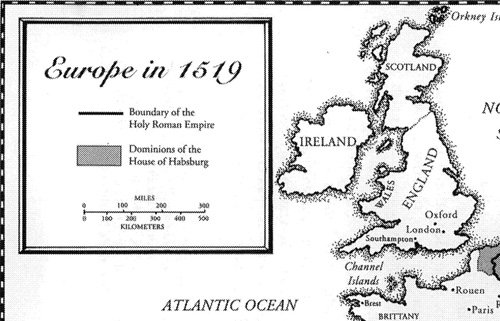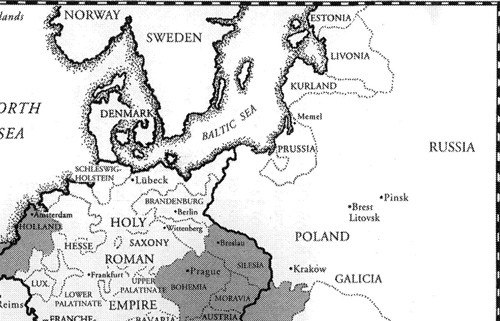A World Lit Only by Fire (9 page)
Read A World Lit Only by Fire Online
Authors: William Manchester

I
N THE VERY BEGINNING
the first Vicars of Christ had withdrawn from the world and its temptations. Now they became indistinguishable from the nobility.
Once they had held the blessings of austerity to be inviolate, even renouncing marriage and cohabitation. Now celibacy yielded
to widespread clerical concubinage and, in the convents, to promiscuity and homes for fatherless children born to women who
had pledged their virtue as brides of Christ.
The precept that men of God should sleep alone, established by the Lateran Councils of 1123 and 1139 after nine hundred years
of hemming and hawing, had begun to fray well before the dawn of the sixteenth century. Now it was a thing of shreds and patches.
The last pontiff to take it seriously had died in 1471, and even he, during his youthful days as a bishop of Trieste, had
slept with a succession of mistresses. A generation later the occupants of Saint Peter’s chair were openly acknowledging their
bantlings, endowing their sons with titles and their daughters with dowries.
In the Vatican nepotism ran amok. Sixtus IV (r. 1471–1484), upon donning the miter, appointed two of his nephews—both dissolute
youths—to the sacred College of Cardinals. Later he put red hats on three more nephews and a grandnephew. He also named
an eight-year-old boy archbishop of Lisbon and an eleven-year-old archbishop of Milan, though, quite apart from the fact that
both were children, neither had received any religious instruction. Innocent VIII, who succeeded Sixtus in 1484, doted on
Franceschetto Cibò, his son by a nameless courtesan. Innocent couldn’t make a cardinal of Franceschetto. Standards had not
deteriorated that far—yet—and the youth didn’t seem interested. What excited him was roaming city streets each night with
a pack of Roman hoodlums, gang-raping young women, some of them nuns; sodomizing them and then leaving them unconscious, bloody,
bruised, often with serious injuries, in the streets. The pope’s son was not only a guttersnipe; he was also one of history’s
great spendthrifts. To support his lifestyle Innocent raised simony to new levels. By the time he found a suitable bride for
Frances-chetto, a Medici, he had to mortgage the papal tiara and treasury to pay for the wedding. Then he appointed his son’s
new brother-in-law to the sacred college. The new cardinal and future pope—Leo X—was fourteen years old.
Even Leo X (r. 1513–1521), who fathered no children, shared the passion to honor papal relatives. He began in 1513 with his
first cousin, Giulio de’ Medici, whose mother, all Rome knew, had been a casual partner at a drunken Holy Week frolic. By
now there were precedents for conferring red hats on illegitimate sons; Alexander VI had put one on his own teenaged bastard,
Cesare Borgia. Leo had big plans for Giulio, so he perjured himself, swearing out an affidavit that the youth’s parents had
been secretly married. He then appointed five more members of his family, three nephews and two first cousins, to the cardinal’s
college. Meantime his hopes for Giulio, like Giulio himself, were maturing. The boy cardinal became a man, served his benefactor
as chief minister, and, in 1523, became pope himself. However, it is just as well that Leo did not live to see his dream realized.
As Clement VII, Giulio was to become the ultimate pontifical disaster.

U
NDISCIPLINED BY PIETY
, most of these popes are nonetheless remembered for their consummate skills in the brutal politics of the era. Only men with
strong power bases of their own, notably leaders of great Italian families—the Sforzas, Medicis, Pazzis, Aragons—dared
challenge them. At the turn of the century the most popular critic of Alexander VI, the Borgia pope, was a Florentine, Girolamo
Savonarola of San Marco, a charismatic, idealistic Dominican friar with an enormous following in Florence, where he had introduced
a democratic government free of corruption. Savonarola (1452–1498) was among those offended by Vatican orgies and Alexander’s
celebrated collection of pornography. The friar’s protests took the form of annual “bonfires of the vanities”—carnivals
in Florence’s Piazza della Signoria, where he tossed lewd pictures, pornography, personal ornaments, cards, and gaming tables
on the flames. To his multitudes he would roar: “Popes and prelates speak against pride and ambition and they are plunged
into it up to their ears.” The papal palace, he said, had literally become a house of prostitution where harlots “sit upon
the throne of Solomon and signal to the passersby. Whoever can pay enters and does what he wishes.”
Savonarola also charged the Vicar of Christ with simony and demanded that he be removed. Alexander at first responded warily,
merely ordering the friar gagged. But Savonarola continued to defy him. The pontiff, he declared “is no longer a Christian.
He is an infidel, a heretic, and as such has ceased to be pope.” The

Girolamo Savonarola (1452–1498)
Holy Father tried to buy him off with a cardinal’s hat. Savonarola indignantly rejected it—“A red hat?” he cried; “I want
a hat of blood!”—and that was the end of him. Alexander excommunicated him; then, when Savonarola again defied him by continuing
to celebrate Mass and give communion, the pope condemned him as a heretic, sentenced him to torture, and finally had him hanged
and burned in the Piazza della Signoria.
The pontiffs of that time cannot be said to have been fastidious. They even executed their enemies in churches, where victims’
bodyguards were likeliest to be caught off guard. Allying himself with the Pazzi family, who were challenging the Florentine
power of Lorenzo de’ Medici—Lorenzo the Magnificent—Pope Sixtus IV conspired with them to murder Lorenzo and his handsome
brother Giuliano. He chose their most defenseless moment, when they were observing High Mass in the Florentine cathedral.
The signal for the killers was the bell marking the elevation of the host. Giuliano fell at the altar, mortally wounded, but
Lorenzo was not called magnificent for nothing. Drawing his long sword, he escaped into the sacristy and barricaded himself
there until help arrived.
If the pope’s attack says much about the era, so does Lorenzo’s vengeance. On his instructions some of the Pazzi gang were
hanged from balconies of the Palace of the Signoria while the rest were emasculated, dragged through the streets, hacked to
death, and flung into the Arno. By medieval standards Lorenzo’s revenge had not been excessive, though that cannot be said
of Denmark’s King Christian II, who invaded Sweden early in 1520. In January, Sten Sture, Sweden’s leader, was killed in action.
Heavy fighting continued throughout the year, however, and it was autumn before Sture’s widow, Dame Christina Gyllenstjerna,
surrendered. Christian had promised her a general amnesty, but a king’s word wasn’t worth much then. He immediately broke
his, and in spectacular fashion. First two Swedish bishops were beheaded in Stockholm’s public square at midnight, November
8, while eighty of their parishioners, who had been summoned to witness the execution, were butchered where they stood. The
Danish king then disinterred Sten Sture’s remains. After ten months in the grave they were scarcely recognizable. Rotting,
crawling with maggots, emitting a nauseous stench, the corpse was nevertheless burned. Next Sture’s small son was flung —
alive—into the flames. Then Dame Christina, who had been forced to watch all this, was sentenced to live out her days as
a common prostitute.

W
HAT WAS
the world like—and to them it was the
only
world, round which the sun orbited each day—when ruled by such men? Imagination alone can reconstruct it. If a modern European
could be transported back five centuries through a kind of time warp, and suspended high above earth in one of those balloons
which fascinated Jules Verne, he would scarcely recognize his own continent. Where, he would wonder, looking down, are all
the people? Westward from Russia to the Atlantic, Europe was covered by the same trackless forest primeval the Romans had
confronted fifteen hundred years earlier, when, according to Tacitus’s
De Germania
, Julius Caesar interviewed men who had spent two months walking from Poland to Gaul without once glimpsing sunlight. One
reason the lands east of the Rhine and north of the Danube had proved unconquerable to legions commanded by Caesar and over
seventy other Roman consuls was that, unlike the other territories he subdued, they lacked roads.
But there
were
people there in
A.D
. 1500. Beneath the deciduous canopy, most of them toiling from sunup to sundown, dwelt nearly 73 million people, and although
that was less than a tenth of the continent’s modern population, there were enough Europeans to establish patterns and precedents
still viable today. Twenty million of them lived in what was known as the Holy Roman Empire—which, in the hoary classroom
witticism, was neither holy, nor Roman, nor an empire. It was in fact central Europe: Germany and her bordering territories.
*
There were 15 million souls in France, Europe’s most populous country. Thirteen million lived in Italy, where the population was densest, 8 million in Spain, and a mere 4.5 million—the number of Philadelphians
in 1990—in England and Wales.


